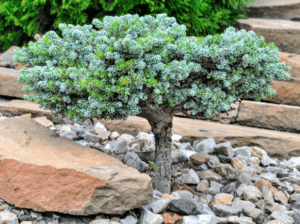
Korean firs (Abies Koreana) are striking evergreen trees that add year-round beauty and structure to any garden. With their dense, soft needles, silvery undersides, and eye-catching purple cones, they create stunning focal points. These relatively compact trees are also surprisingly low-maintenance, making them an excellent choice for novice and experienced gardeners.
Korean Fir Fundamentals
- Description: Korean firs boast a classic pyramidal shape with short, upward-curving needles. Their unique blue-green needles have silvery-white undersides, giving the tree a shimmery appearance. In spring and summer, vibrant purple cones decorate the branches.
- Botanical Information:
- Common Name: Korean fir
- Botanical Name: Abies koreana
- Family: Pinaceae (Pine family)
- Plant Type: Evergreen tree
- Mature Size: 15–30 ft. tall, 6–12 ft. wide
- Sun Exposure: Full sun to partial shade
- Soil Type: Moist, well-drained, acidic
- Soil pH: Acidic (5.5 – 6.5)
- Hardiness Zones: 5–7 (USDA)
- Native Area: South Korea
Ideal Growing Conditions
Amending Your Soil for Optimal Results
- Clay Soil Recommendations: Korean firs will benefit from generous amendments if you have heavy clay soil. Before planting, work in ample amounts of compost, peat moss, or well-rotted manure to improve drainage and increase acidity.
- Alkaline Soil: Address alkaline conditions: Incorporate elemental sulfur following package instructions to lower the pH for alkaline soils. Retest your soil after amending to ensure it falls within the acidic range Korean firs prefer.
- Sun Exposure: Korean firs thrive in full sun but can tolerate some partial shade.
- Soil Type & pH: These trees prefer rich, moist, well-drained soil with an acidic pH. If your soil is heavy clay or alkaline, amend it generously with compost or peat moss before planting.
- Location Considerations: Choose a planting spot carefully, as Korean firs don’t like being transplanted. Pick a place with ample room for them to reach their mature size.
Planting Your Korean Fir
-
Step-by-Step Guide:
- Best Time: Plant in fall or early spring.
- Root Preparation: Gently loosen any circling roots.
- Hole: Dig a hole twice as wide as the root ball and slightly shallower.
- Planting: Place the tree, ensuring the top of the root ball is level with the ground. Backfill, gently tamping down the soil.
- Spacing: Plant Korean firs at least 15 feet apart.
- Mulching & Initial Watering: Apply a thick layer of mulch to conserve moisture and suppress weeds. Water deeply immediately after planting.
Korean Fir Care & Maintenance
- Watering: Water young trees regularly, especially during hot, dry periods. Deeply water about once a week. Established trees are more drought-tolerant but still benefit from supplemental watering during dry spells.
- Fertilizing: Feed annually in spring with a balanced, slow-release fertilizer formulated for acid-loving evergreens, such as a 10-10-5 fertilizer designed for azaleas and rhododendrons.”
- Common Pests & Diseases: These trees are relatively problem-free but may occasionally be affected by aphids or spider mites. Watch for signs of infestation and address them promptly.
Pruning for Shape and Health
- Korean firs naturally maintain a beautiful pyramidal shape and require minimal pruning. Focus mainly on removing any dead, damaged, or diseased branches.
- Addressing Shaping: If you wish to shape your tree lightly, the best time for pruning is late winter or early spring before new growth emerges. Avoid removing over one-third of the new growth in a single season.”
Troubleshooting Common Issues
While Korean firs are relatively problem-free, watch for a few potential issues. Needle browning could indicate sun scorch, especially on young trees. If your tree appears sparse or lacks its usual dense growth, ensure it’s receiving sufficient sunlight.
Dwarf Korean Fir Varieties for Small Gardens
If you have a smaller garden or even just a sunny patio, don’t think you have to miss out on the beauty of a Korean fir! Dwarf Korean fir varieties offer the same striking foliage, colorful cones, and classic evergreen structure but in a compact package ideally suited for tight spaces.
- ‘Silberlocke’: Known for its firmly curled needles that reveal shimmering silver undersides. It is a popular choice due to its unique appearance that remains eye-catching year-round. This slow-grower will eventually reach 10-15 feet tall, making it an excellent long-term focal point.

- ‘Compact Dwarf’: One of the slowest-growing Korean firs, topping out at just 4-6 feet at maturity, making it ideal for rock gardens or borders. Its dense growth habit and soft blue-green needles provide a lush texture even in small spaces.

Cis: This naturally spreading dwarf variety has a mounded form and soft needles. It’s perfect for cascading over rocks or walls, adding a touch of evergreen drama. ‘Cis’ typically matures between 2-3 feet tall and wide.

Oberon: A dense, compact variety with bright green needles. It maintains a neat, rounded shape and grows slowly to 3-4 feet tall—an excellent choice for a low-maintenance evergreen foundation planting.

Growing Tips
-
Containers: Dwarf Korean firs thrive in containers, making them a great option for patios or balconies. Choose a well-draining potting mix and a pot with adequate drainage holes.
-
Light: Plant in a location with full sun to partial shade.
-
Soil: Korean firs prefer moist, well-drained, acidic soil. Amend with compost or peat moss before planting.
Best Korean Fir Varieties for Cold Climates
Choosing a cold-hardy Korean fir variety is crucial if you live in a region with harsh winters. These cultivars are bred to withstand freezing temperatures and icy winds, ensuring they thrive in challenging climates.
-
‘Silberlocke’: A popular choice for its adaptability and striking appearance. ‘Silberlocke’ can tolerate temperatures below -30°F (USDA Zone 5). Its beautiful foliage provides year-round interest.
-
‘Horstmann’s Silberlocke’: Another exceptionally cold-tolerant variety known for its dramatic form. With its broad base and upsweeping branches, it’s an actual statement piece in the landscape and can handle temperatures as low as -30 °F (USDA Zone 5).

-
‘Compact Dwarf’: This remarkably hardy variety is among the most cold-tolerant Korean firs available. It thrives in USDA Zones 5-7, weathering frigid winters without losing its lush appearance.
-
‘Kohout’s Icebreaker’: Explicitly developed for cold climates, this cultivar features uniquely twisted needles and exciting texture. It’s hardy to USDA Zone 5, adding a touch of whimsy to winter landscapes.

Winter Interest: Korean firs offer beautiful features even in the depths of winter. Their colorful cones and evergreen foliage add life to a snowy landscape. The curled needles of cultivars like ‘Silberlocke’ can also catch frost or light snow, creating a magical effect.
Landscaping with Korean Fir
-
Specimen Plant: Korean firs make a gorgeous focal point in the landscape.

-
Hedges: Plant in a row to create a dense, beautiful privacy screen.

-
Foundation Plantings: Their compact size works well around the base of a home.

-
Container Growing: Dwarf varieties thrive in large containers.

Let Your Korean Fir Shine
With minimal care, your Korean fir will reward you with lasting beauty. If you’re searching for a low-maintenance evergreen that brings year-round interest, look no further than this exquisite tree!

























